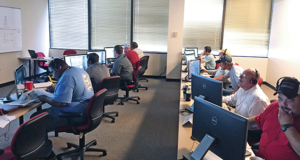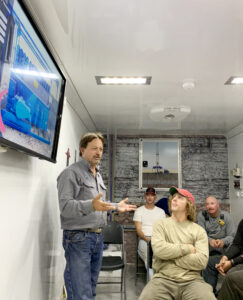Hidden costs from forgoing effective well control training can outweigh actual cost of training
Steve L. Richert, Wild Well Control
To ensure that revenue exceeds company costs, it is imperative that employee training be completed to maximize productivity and minimize the risks of nonproductive time, which includes well control events. Training improves a company’s intellectual capital, which increases revenue to an extent far exceeding the cost of schooling.
What is the cost if we do not train?
Knowledge is less expensive than ignorance. Human ignorance can be dangerous and costly. Without humans, machines will not run, technology will neither write nor maintain itself, and business will not be conducted. Trained people are the most valuable asset of any organization. Conversely, untrained humans create serious problems.

A recent US Chemical Safety Board (CSB) report on a 2018 blowout stated that the operation was “performed without the correct equipment, procedures, and training.” It also noted that crews were not properly and effectively trained in the performed operations.
The oil and gas industry is considered one of the most hazardous working environments in the US. Multimillion-dollar costs can be easily identified when there is a major well control event, injury or death that could have been prevented with better training.
Further, there are hidden costs associated with the reduced productivity, poor product quality and increased risk of major catastrophe, which potentially create an even greater loss to company revenues. These hidden costs are often neither recognized nor considered.
Henry Ford, one of the most successful businessmen in the past two centuries, is credited with this statement, “The only thing worse than training your employees and having them leave is not training them and having them stay.” Untrained workers make more mistakes, are less efficient, waste more time and eventually cause a company’s reputation to be damaged because of customer dissatisfaction.
Lack of training damages a company’s bottom line much more than the cost of effective training.
What is effective training?
Knowledge is not acquired by osmosis – it comes from training. Effective training teaches an employee how to “think” about a task versus merely how to “do” a task. Too often, employees are only taught the mechanics of how to do the job. To fully comprehend the work, training is needed beyond processes and procedures. Students should be taught to react to well control events in the field by giving them the skills to think and discover what they need to know. By improving an employee’s ability to think about the work to be done, the company’s intellectual capital increases.
If we spend the money to train, what is the return on investment? The sum of all the knowledge within a company is intellectual capital. This capital cultivates innovation, generating positive change, which results in more efficient production, improved product quality and greater customer satisfaction. When combined, these factors can earn a company the reputation as the “go to” group of people to get the job done. In this way, training improves intellectual capital, which generates the return on the training investment.
Unfortunately, because intellectual capital is considered an intangible asset, many companies find it “profitable” to very quickly cut expenses by eliminating training, thus removing the cost from the liability column in the financial books. Regrettably, this action overlooks the intangible asset of intellectual capital and the revenue it generates.
Many companies view intellectual capital as only upper management or technically skilled workers, such as engineers. It is most important to train rig workers because, in the well control arena, that is where the rubber meets the road in relation to blowouts. The training of all employees at their skill level generates intellectual capital, improves safety and results in increased profits.
Customer satisfaction because of employee performance generates both today’s revenue and the promise of business to come. Companies that look to the future invest in training.
Well control training
For oil and gas wells, risk management begins with the planning of a well and ends with plugging, abandonment and monitoring of the spent well. In the areas of rig crew training and well control, the main source of risk is the potential for uncontrolled release of hydrocarbons and other formation fluids to the surface.

The highly explosive nature of methane gas means that an uncontrolled release to surface can cause an explosion and fire, which could destroy life, property and the environment. If a rig crew is unable to properly anticipate the potential for a release, the entire drilling operation can be considered high risk. Today’s drilling crews need people who are trained, knowledgeable, skilled and regularly retrained to prevent catastrophic blowout events.
Because the science of well control never varies, but wells and the application of the science changes, training courses should teach not only how to do well control but also how to think about well control – not just the “what” but also the “why.”
Students should be encouraged to go beyond memorizing facts and undertake higher-level learning for higher-level thinking.
Attention to the details of how humans learn, which include visual, auditory and kinesthetic (hands-on) styles, improves knowledge retention. Other lesser-known learning styles such as aural (music) and logical (critical thinking/discussion/debate) can be applied, as well.
With the IADC WellSharp curriculum, the industry has enhanced the required knowledge content. WellSharp certification testing is much more rigorous in that the testing is centralized with IADC, and the exams are proctored by a third party. A good training and certification program will expand the WellSharp curriculum beyond the required content.
For instance, the WellSharp drilling certification course requires 24 hours of class and three hours of testing. To accommodate the extra training needed, Wild Well has increased the length of the certification course from 24 hours to 36 hours.
Several further training projects have been developed, including an online Introduction to Drilling Operations course, developed with 3D software.
However, it has become obvious that the rig crew – the first line of well control defense – is where training needs to be focused. The introduction of mobile classrooms, training at the rig, is intended to accomplish that objective.
Mobile training classrooms, working in combination with kick drills, take well control to the crew members who do not get the chance to attend well control school – derrick hands, rig mechanics and floorhands. The training curriculum focuses on:
- What causes hydrocarbon influxes in a well;
- What equipment the rig crews maintain and function to control the well;
- How to recognize influxes around the rig without computer equipment; and
- How to shut the well in and capture the influx in a safe and efficient manner. Once the well is shut in, the supervisors and engineers can take over to safely resolve the situation.
In a two-hour class, this mobile training solution instructs the very people who are the first to see an influx, and often the people who are the least trained to recognize and react to it. The crews are trained with their own team members on their own rigs.
Risk mitigation is a crucial part of properly managing today’s business. Most companies realize the advantages to risk management but do not have the tools to assess, write or properly implement a plan. In well control, risk management begins with training that teaches the “what” and the “why,” and emphasizes not only how to do but also how to think.
Training is one solution to risk management, but risk plan implementation and subsequent follow-up are imperative. Risk management involves identifying the risks (kick drills), writing a plan that includes training, and being certain that executive policies/procedures are followed in the field.
Conclusion
On the balance sheet, the revenue that a worker generates is an asset entry opposite of the liability of employee salary, benefits and training. A trained workforce contributes intellectual capital, which lowers risk, drives innovation and improves revenue. The profits generated by an effectively trained workforce go directly to the bottom line.
When companies either lay off intellectual capital when attempting to cut expenses, or do not train employees due to the cost, everyone loses.
Michael Leboeuf, an author and a professor emeritus from the University of New Orleans, wrote in his book “The Greatest Management Principle in the World”: “If you believe that training is expensive, it is because you do not know what ignorance costs. Companies that have the loyalty of their employees invest heavily in permanent training programs and promotion systems.” DC




